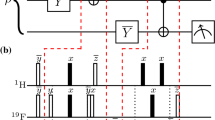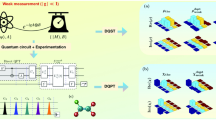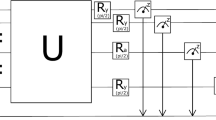Abstract
We introduce a protocol to classify three-qubit pure states into different entanglement classes and implement it on an NMR quantum processor. The protocol is designed in such a way that the experiments performed to classify the states can also measure the amount of entanglement present in the state. The classification requires the experimental reconstruction of the correlation matrices using 13 operators. The rank of the correlation matrices provides the criteria to classify the state in one of the five classes, namely separable, biseparable (of three types), and genuinely entangled (of two types, GHZ and W). To quantify the entanglement, a concurrence function is defined which measures the global entanglement present in the state, using the same 13 operators. Global entanglement is zero for separable states and nonzero otherwise. We demonstrate the efficacy of the protocol by implementing it on states chosen from each of the six inequivalent (under stochastic local operations and classical communication) classes for three qubits. We also implement the protocol on states picked at random from the state space of three-qubit pure states.
Graphic Abstract






Similar content being viewed by others
Data Availability Statement
This manuscript has no associated data or the data will not be deposited. [Authors’ comment: The datasets generated analyzed during the current study are available from the corresponding author on reasonable request.]
References
R. Horodecki, P. Horodecki, M. Horodecki, K. Horodecki, Quantum entanglement. Rev. Mod. Phys. 81, 865–942 (2009). https://doi.org/10.1103/RevModPhys.81.865
O. Gühne, G. Tóth, Entanglement detection. Phys. Rep. 474(1), 1–75 (2009). https://doi.org/10.1016/j.physrep.2009.02.004
C. Eltschka, J. Siewert, Maximum \(N\)-body correlations do not in general imply genuine multipartite entanglement. Quantum 4, 229 (2020). https://doi.org/10.22331/q-2020-02-10-229
M. Enríquez, I. Wintrowicz, K. Życzkowski, Maximally entangled multipartite states: a brief survey. J. Phys.: Conf. Ser. 698, 012003 (2016). https://doi.org/10.1088/1742-6596/698/1/012003
W. Dur, G. Vidal, J.I. Cirac, Three qubits can be entangled in two inequivalent ways. Phys. Rev. A 62, 062314 (2000). https://doi.org/10.1103/PhysRevA.62.062314
M.M. Cunha, A. Fonseca, E.O. Silva, Tripartite entanglement: foundations and applications. Universe 5(10), 209 (2019). https://doi.org/10.3390/universe5100209
M. Li, S.-M. Fei, X. Li-Jost, H. Fan, Genuine multipartite entanglement detection and lower bound of multipartite concurrence. Phys. Rev. A 92, 062338 (2015). https://doi.org/10.1103/PhysRevA.92.062338
M. Sanz, I.L. Egusquiza, R. Di Candia, H. Saberi, L. Lamata, E. Solano, Entanglement classification with matrix product states. Sci. Rep. 6(1), 30188 (2016). https://doi.org/10.1038/srep30188
M. Li, J. Wang, S. Shen, Z. Chen, S.-M. Fei, Detection and measure of genuine tripartite entanglement with partial transposition and realignment of density matrices. Sci. Rep. 7(1), 17274 (2017). https://doi.org/10.1038/s41598-017-17585-7
L.-M. Yang, B.-Z. Sun, B. Chen, S.-M. Fei, Z.-X. Wang, Quantum Fisher information-based detection of genuine tripartite entanglement. Quantum Inf. Process. 19(8), 262 (2020). https://doi.org/10.1007/s11128-020-02766-7
A. Ketterer, N. Wyderka, O. Gühne, Entanglement characterization using quantum designs. Quantum 4, 325 (2020). https://doi.org/10.22331/q-2020-09-16-325
W.-C. Qiang, G.-H. Sun, Q. Dong, O. Camacho-Nieto, S.-H. Dong, Concurrence of three Jaynes–Cummings systems. Quantum Inf. Process. 17(4), 90 (2018). https://doi.org/10.1007/s11128-018-1851-8
W.-C. Qiang, G.-H. Sun, Q. Dong, S.-H. Dong, Genuine multipartite concurrence for entanglement of Dirac fields in noninertial frames. Phys. Rev. A 98, 022320 (2018). https://doi.org/10.1103/PhysRevA.98.022320
A.J. Torres-Arenas, Q. Dong, G.-H. Sun, W.-C. Qiang, S.-H. Dong, Entanglement measures of W-state in noninertial frames. Phys. Lett. B 789, 93–105 (2019). https://doi.org/10.1016/j.physletb.2018.12.010
W.-C. Qiang, Q. Dong, M.A. Mercado Sanchez, G.-H. Sun, S.-H. Dong, Entanglement property of the Werner state in accelerated frames. Quantum Inf. Process. 18(10), 314 (2019). https://doi.org/10.1007/s11128-019-2421-4
S. Dogra, K. Dorai, Experimental construction of generic three-qubit states and their reconstruction from two-party reduced states on an NMR quantum information processor. Phys. Rev. A 91, 022312 (2015). https://doi.org/10.1103/PhysRevA.91.022312
D. Das, S. Dogra, K. Dorai, Experimental construction of a W superposition state and its equivalence to the Greenberger–Horne–Zeilinger state under local filtration. Phys. Rev. A 92, 022307 (2015). https://doi.org/10.1103/PhysRevA.92.022307
A. Singh, H. Singh, K. Dorai, Experimental classification of entanglement in arbitrary three-qubit pure states on an NMR quantum information processor. Phys. Rev. A 98, 032301 (2018). https://doi.org/10.1103/PhysRevA.98.032301
A. Singh, K. Dorai, Experimentally identifying the entanglement class of pure tripartite states. Quantum Inf. Process. 17(12), 334 (2018). https://doi.org/10.1007/s11128-018-2105-5
T. Xin, J.S. Pedernales, E. Solano, G.-L. Long, Entanglement measures in embedding quantum simulators with nuclear spins. Phys. Rev. A 97, 022322 (2018). https://doi.org/10.1103/PhysRevA.97.022322
A. Singh, D. Singh, V. Gulati, K. Dorai, Experimental detection of non-local correlations using a local measurement-based hierarchy on an NMR quantum processor. Eur. Phys. J. D 74(8), 168 (2020). https://doi.org/10.1140/epjd/e2020-10173-9
D. Bouwmeester, J.-W. Pan, M. Daniell, H. Weinfurter, A. Zeilinger, Observation of three-photon Greenberger–Horne–Zeilinger entanglement. Phys. Rev. Lett. 82, 1345–1349 (1999). https://doi.org/10.1103/PhysRevLett.82.1345
J. Zhu, M.-J. Hu, S. Cheng, M.J.W. Hall, C.-F. Li, G.-C. Guo, Y.-S. Zhang, Experimental verification of anisotropic invariance for three-qubit states. Phys. Rev. A 99, 040103 (2019). https://doi.org/10.1103/PhysRevA.99.040103
X.-P. Zang, M. Yang, F. Ozaydin, W. Song, Z.-L. Cao, Deterministic generation of large scale atomic W states. Opt. Express 24(11), 12293–12300 (2016). https://doi.org/10.1364/OE.24.012293
M. Neeley, R.C. Bialczak, M. Lenander, E. Lucero, M. Mariantoni, A.D. O’Connell, D. Sank, H. Wang, M. Weides, J. Wenner, Y. Yin, T. Yamamoto, A.N. Cleland, J.M. Martinis, Generation of three-qubit entangled states using superconducting phase qubits. Nature 467(7315), 570–573 (2010). https://doi.org/10.1038/nature09418
D. Erdösi, M. Huber, B.C. Hiesmayr, Y. Hasegawa, Proving the generation of genuine multipartite entanglement in a single-neutron interferometer experiment. N. J. Phys. 15(2), 023033 (2013). https://doi.org/10.1088/1367-2630/15/2/023033
J.I. de Vicente, M. Huber, Multipartite entanglement detection from correlation tensors. Phys. Rev. A 84, 062306 (2011). https://doi.org/10.1103/PhysRevA.84.062306
S. Wang, Y. Lu, G.-L. Long, Entanglement classification of \(2\times 2 \times 2\times d\) quantum systems via the ranks of the multiple coefficient matrices. Phys. Rev. A 87, 062305 (2013). https://doi.org/10.1103/PhysRevA.87.062305
H. Zhao, M.-M. Zhang, N. Jing, Z.-X. Wang, Separability criteria based on Bloch representation of density matrices. Quantum Inf. Process. 19(1), 14 (2020). https://doi.org/10.1007/s11128-019-2504-2
M. Li, L. Jia, J. Wang, S. Shen, S.-M. Fei, Measure and detection of genuine multipartite entanglement for tripartite systems. Phys. Rev. A 96, 052314 (2017). https://doi.org/10.1103/PhysRevA.96.052314
L. Knips, J. Dziewior, W. Kłobus, W. Laskowski, T. Paterek, P.J. Shadbolt, H. Weinfurter, J.D.A. Meinecke, Multipartite entanglement analysis from random correlations. NPJ Quantum Inf. 6(1), 51 (2020). https://doi.org/10.1038/s41534-020-0281-5
G. Sarbicki, G. Scala, D. Chruś ściń ński, Family of multipartite separability criteria based on a correlation tensor. Phys. Rev. A 101, 012341 (2020). https://doi.org/10.1103/PhysRevA.101.012341
I.S. Oliveira, T.J. Bonagamba, R.S. Sarthour, J.C.C. Freitas, E.R. deAzevedo, NMR Quantum Information Processing. Elsevier, Linacre House, Jordan Hill, Oxford OX2 8DP, UK (2007)
D.O. Soares-Pinto, R. Auccaise, J. Maziero, A. Gavini-Viana, R.M. Serra, L.C. Céleri, On the quantumness of correlations in nuclear magnetic resonance. Philos. Trans. R. Soc. A 370(1976), 4821–4836 (2012). https://doi.org/10.1098/rsta.2011.0364
R.F. Werner, Quantum states with Einstein–Podolsky–Rosen correlations admitting a hidden-variable model. Phys. Rev. A 40, 4277–4281 (1989). https://doi.org/10.1103/PhysRevA.40.4277
I. Bengtsson, K. Zyczkowski, Geometry of Quantum States: An Introduction to Quantum Entanglement. Cambridge University Press (2006). https://doi.org/10.1017/CBO9780511535048
T.G. Kolda, B.W. Bader, Tensor decompositions and applications. SIAM Rev. 51(3), 455–500 (2009). https://doi.org/10.1137/07070111X
A. Acín, A. Andrianov, L. Costa, E. Jané, J.I. Latorre, R. Tarrach, Generalized Schmidt decomposition and classification of three-quantum-bit states. Phys. Rev. Lett. 85, 1560–1563 (2000). https://doi.org/10.1103/PhysRevLett.85.1560
V. Coffman, J. Kundu, W.K. Wootters, Distributed entanglement. Phys. Rev. A 61, 052306 (2000). https://doi.org/10.1103/PhysRevA.61.052306
S. Hill, W.K. Wootters, Entanglement of a pair of quantum bits. Phys. Rev. Lett. 78, 5022–5025 (1997). https://doi.org/10.1103/PhysRevLett.78.5022
X. Guo, C.T. Ma, Violation \(\ne \) quantum. arXiv (2021). https://doi.org/10.48550/ARXIV.2109.03871
X. Guo, C.T. Ma Tripartite entanglement and quantum correlation. arXiv (2021) arXiv:2103.02983 [quant-ph]
D.A. Meyer, N.R. Wallach, Global entanglement in multiparticle systems. J. Math. Phys. 43(9), 4273–4278 (2002). https://doi.org/10.1063/1.1497700
G.K. Brennen, An observable measure of entanglement for pure states of multi-qubit systems. Quantum Inf. Comput. 3(6), 619–626 (2003)
J.S. Kim, B.C. Sanders, Monogamy of multi-qubit entanglement using Rényi entropy. J. Phys. A: Math. Theor. 43(44), 445305 (2010). https://doi.org/10.1088/1751-8113/43/44/445305
D.G. Cory, M.D. Price, T.F. Havel, Nuclear magnetic resonance spectroscopy: an experimentally accessible paradigm for quantum computing. Phys. D: Nonlinear Phenom. 120(1–2), 82–101 (1998). https://doi.org/10.1016/s0167-2789(98)00046-3
A. Mitra, K. Sivapriya, A. Kumar, Experimental implementation of a three qubit quantum game with corrupt source using nuclear magnetic resonance quantum information processor. J. Magn. Reson. 187(2), 306–313 (2007). https://doi.org/10.1016/j.jmr.2007.05.013
H. Singh, K. Arvind Dorai, Evolution of tripartite entangled states in a decohering environment and their experimental protection using dynamical decoupling. Phys. Rev. A 97, 022302 (2018). https://doi.org/10.1103/PhysRevA.97.022302
N. Khaneja, T. Reiss, C. Kehlet, T. Schulte-Herbrüggen, S.J. Glaser, Optimal control of coupled spin dynamics: design of NMR pulse sequences by gradient ascent algorithms. J. Magn. Reson. 172(2), 296–305 (2005). https://doi.org/10.1016/j.jmr.2004.11.004
G.L. Long, H.Y. Yan, Y. Sun, Analysis of density matrix reconstruction in NMR quantum computing. J. Opt. B Quantum Semiclassical Opt. 3(6), 376–381 (2001). https://doi.org/10.1088/1464-4266/3/6/305
G.M. Leskowitz, L.J. Mueller, State interrogation in nuclear magnetic resonance quantum-information processing. Phys. Rev. A 69, 052302 (2004). https://doi.org/10.1103/PhysRevA.69.052302
H. Singh, K. Dorai, Constructing valid density matrices on an NMR quantum information processor via maximum likelihood estimation. Phys. Lett. A 380(38), 3051–3056 (2016). https://doi.org/10.1016/j.physleta.2016.07.046
A. Gaikwad, K. Shende, K. Dorai, Experimental demonstration of optimized quantum process tomography on the IBM quantum experience. Int. J. Quantum Inf. 19(07), 2040004 (2021). https://doi.org/10.1142/S0219749920400043
R. Jozsa, Fidelity for mixed quantum states. J. Mod. Opt. 41(12), 2315–2323 (1994). https://doi.org/10.1080/09500349414552171
A. Uhlmann, The transition probability in the state space of a *-algebra. Rep. Math. Phys. 9(2), 273–279 (1976). https://doi.org/10.1016/0034-4877(76)90060-4
R.I. Wolfram, Mathematica, Version 12.0. Champaign, IL (2019)
Acknowledgements
All experiments were performed on a 600 MHz FT-NMR spectrometer at the NMR Research Facility IISER Mohali. Arvind acknowledges financial support from DST/ICPS/QuST/Theme-1/2019/General Project Number Q-68. K.D. acknowledges financial support from DST/ICPS/QuST/Theme-2/2019/General Project Number Q-74.
Author information
Authors and Affiliations
Contributions
VG performed the experiments. VG, KD and Arvind discussed the physics, experimental and computational results and jointly wrote the manuscript. KD and Arvind supervised the project.
Corresponding author
Ethics declarations
Conflict of interest
The authors have no conflict of interest.
Rights and permissions
Springer Nature or its licensor (e.g. a society or other partner) holds exclusive rights to this article under a publishing agreement with the author(s) or other rightsholder(s); author self-archiving of the accepted manuscript version of this article is solely governed by the terms of such publishing agreement and applicable law.
About this article
Cite this article
Gulati, V., Arvind & Dorai, K. Classification and measurement of multipartite entanglement by reconstruction of correlation tensors on an NMR quantum processor. Eur. Phys. J. D 76, 194 (2022). https://doi.org/10.1140/epjd/s10053-022-00527-y
Received:
Accepted:
Published:
DOI: https://doi.org/10.1140/epjd/s10053-022-00527-y




